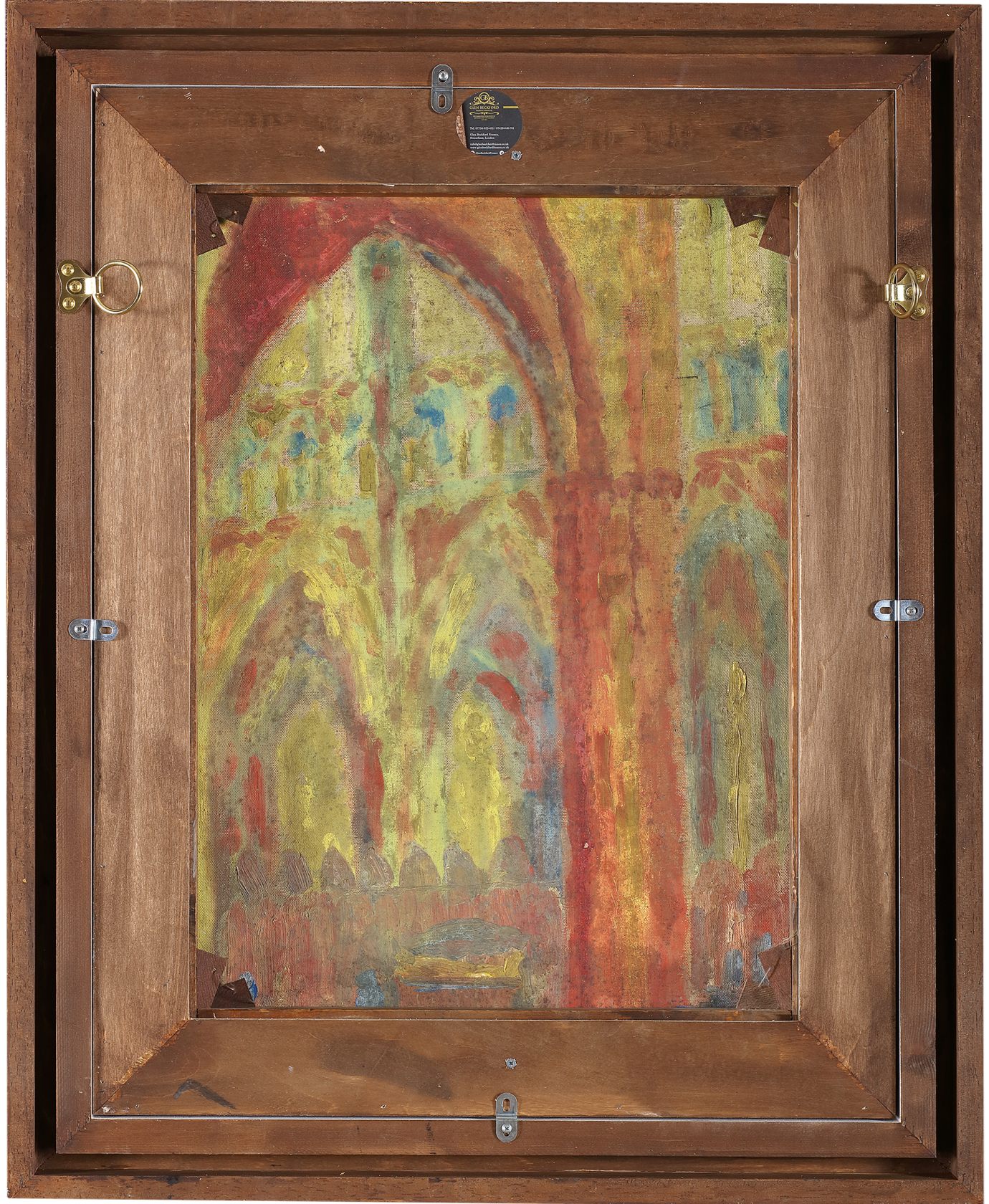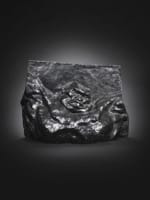It is hard to overstate the importance of this work within Henri Gaudier-Brzeska’s oeuvre. This exceptionally rare oil on canvas portrays the artist’s own reflection alongside his first formal commission, a plaster of a Madonna, now in the collection of Kettle’s Yard.[1] In fact, only three oil paintings on canvas appear to be recorded in Gaudier-Brzeska's body of work, and the present work is one of only two recorded painted self-portraits by the artist.
Gaudier is revered as an innovative sculptor and artist who, despite his tragically short career, was immensely prolific, producing around 120 sculptures and over 2000 works on paper. However, upon moving to London in 1911 as an aspiring artist, Gaudier struggled to garner commissions. Afflicted by abject poverty, his frayed shirts and less than ‘sharp’ appearance dissatisfied the upper echelons of society, whose commissions he coveted.[2] To financially facilitate his artistic ambitions, he worked as a clerk in the City of London and frequented local public...
It is hard to overstate the importance of this work within Henri Gaudier-Brzeska’s oeuvre. This exceptionally rare oil on canvas portrays the artist’s own reflection alongside his first formal commission, a plaster of a Madonna, now in the collection of Kettle’s Yard.[1] In fact, only three oil paintings on canvas appear to be recorded in Gaudier-Brzeska's body of work, and the present work is one of only two recorded painted self-portraits by the artist.
Gaudier is revered as an innovative sculptor and artist who, despite his tragically short career, was immensely prolific, producing around 120 sculptures and over 2000 works on paper. However, upon moving to London in 1911 as an aspiring artist, Gaudier struggled to garner commissions. Afflicted by abject poverty, his frayed shirts and less than ‘sharp’ appearance dissatisfied the upper echelons of society, whose commissions he coveted.[2] To financially facilitate his artistic ambitions, he worked as a clerk in the City of London and frequented local public houses, offering to draw customers for a penny each. This work depicts the artist’s first commission, requested from the young couple Thomas Leman Hare and Thérèse Hare. The Hare’s became two of the artist’s biggest advocates and subsequently commissioned the present painting, which was likely executed in their home at 35 Pembroke Road, Earls Court, London.[3]
The Leman Hare’s original commission was a small statue of Princess Norina Matchabelli (acting name Madame Maria Carmi), who was then playing a leading role in Carl Vollmöller and Max Reinhardt’s sensational production The Miracle. The elaborate performance ran from December 1911 to February 1912 at the Great Hall, Olympia and boasted ‘vast crowd scenes, processions, real horses and an entire moving hill’, set within the interior of a medieval church, likely that depicted on the reverse of the present work [fig. 1]. The Hares, as recorded by Gaudier, were enraptured by Carmi’s performance and had returned to see the play eight times. On the night of the final performance, Mrs Hare rang the doorbell of Gaudier’s home and proposed the commission, requesting that he and his partner Sophie accompany her immediately to the Great Hall. That evening, Gaudier took sixty sketches of the performance from which he produced the final sculpture [fig. 2]. Gaudier described the process in a letter to the Hare’s good friend Haldane Macfall: ‘Off we went as tired as could be, made about sixty sketches of the subject, came back home…at 1 o’clock yesterday, and spent the whole morning putting up the clay for the thing.’[4]
Depicting the sculpture in full polychrome, the present work offers an interesting insight into the artist’s early sculptural working method. The pigments of Gauider’s original plaster have since faded [fig. 3]. However, in a letter to Macfall, Gaudier notes that Thomas Hare suggested painting the sculpture in bright colours; ‘Mr Hare gave me a very good idea. He suggested that I should indicate on the plaster cast the different colours gold, red and blue and this I will do.’[5] Employing a fauvist colour palette and a sculptor's discerning understanding of form, Gaudier has captured the once vibrant contours of his own artistic creation.
The small figure positioned in the lower left corner of the composition may also depict another early work by Gaudier. Gaudier began visiting the Zoo in late 1911, where he became particularly fascinated with gorillas and chimpanzees, fervently creating drawings and small plaster models of the animals he encountered. Claude Lovatt Fraser, an artist, designer, and Fellow of the Zoological Society, generously granted Gaudier complimentary green tickets to the Zoo, a resource that significantly enriched his artistic practice. Fraser also purchased a jungle cat model from him for £2. A head-and-shoulders study of a gorilla, known to have been cast in bronze in 1938, bares striking compositional similarities to the small figure shown on the left side, positioned behind the Madonna plaster, and possibly indicates the existence of a related sculpture [fig. 4].
Gaudier depicts his own self-portrait, poised with a paintbrush, situated behind the Madonna. His featureless face echoes the mask-like faces of Henri Matisse’s paintings such as Dance and Dance I. Only one other self-portrait is known to have been painted by Gaudier in oil and is much more traditional in style. In this self-portrait, brazenly modern in its conception, Gaudier gives prominence to his work, placing himself in the background, calling into question the delicate balance between an artist and their creations.
The Hare’s continued to invest in Gaudier’s practice throughout his short career and assisted him in securing a studio: ‘Tommy and Chuquie have put quite a pace on to find me a studio … Tommy, with his knowing air, has given me to understand that if I take a studio he wants me to take he will get me some orders for illustrations.’[6] This painting may be the composition referred to in a letter by Gaudier to his partner, Sophie Brzeska, penned after the original sculpture commission; ‘Yesterday I made a fairly good composition for Tomsy [Mr Hare] and I will paint it on Sunday.’[7]
With only three recorded oil paintings to his name, this self-portrait stands as a testament to Gaudier’s unconventional path as an artist. The artist’s struggle for commissions in the bustling artistic landscape of early twentieth-century London, where financial hardship often overshadowed creative brilliance, is vividly captured in this work. It converges Gaudier’s early artistic ambition, innovation and the friendships that became central to his tumultuous yet passionate pursuit of art.
[1] Henri Gaudier-Brzeska, Madonna (Maria Carmi as the Madonna), 1912. Kettle’s Yard: https://www.kettlesyard.cam.ac...
[2] H. E. Ede, (2011) Savage Messiah. Cambridge: Kettle’s Yard and Henry Moore Institute, p.42
[3] Thomas Leman Hare was a publisher and collector and in the 1920s became editor of Apollo magazine.
[4] Henri Gaudier-Brzeska, quoted in P. O’Keefe, (2004) Gaudier-Brzeska: An Absolute Case of Genius. London: Allen Lane.
[5] Referenced in Sophie Brzeska, (2008) Matka and Other Writings. London: Mercury Graphics. We are grateful to Dr Evelyn Silber for her assistance with this reference.
[6] H. E. Ede, Savage Messiah. Cambridge: Kettle’s Yard and Henry Moore Institute, 2011, p. 162
[7] Henri Gaudier-Brzeska, Letter to Sophie Brzeska. 11 Oct 1912. quoted in H. E. Ede (2011) Savage Messiah. Cambridge: Kettle’s Yard and Henry Moore Institute, p. 115.













